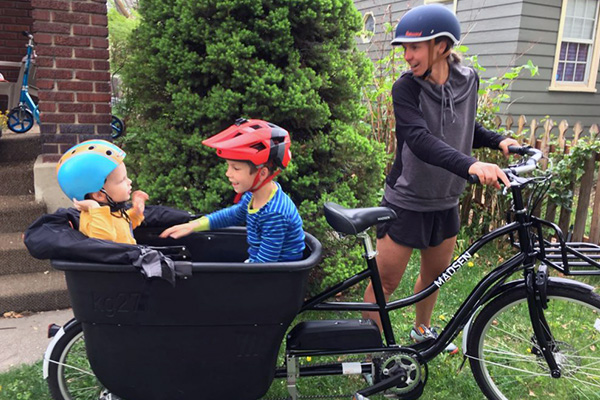As cities worldwide set ambitious targets for reaching Net Zero, many are turning to electric vehicles (EVs) to help reduce emissions in time. There is a compelling case for e-bike subsidies. Evidence that cycling is ten times more important than EVs for decarbonising the network is riveting. In addition, investing in bicycle infrastructure is crucial for creating sustainable, liveable cities.
To reach our climate targets faster, Australia’s bicycle advocates are calling for e-bike subsidies to make cycling more accessible and widely affordable.
The second or even the first family car – e-bike are way more fun for kids! (Source: Rascal Rides)
E-bikes use one 40th of the energy required to build an EV
Electric cars still require electricity to operate. Of course, in many places, that electricity is generated using fossil fuels. So, while electric cars are better than internal combustion engines (ICE) vehicles, they’re far from emissions-free. In contrast, cycling requires no fuel and e-bikes use one 40th of the emissions required to build an EV, making bikes the most sustainable and efficient mode of transportation available.
In the space required for one vehicle (EV or ICE) you can fit 8 e-bikes.
Whether on the road or sitting on the street, cars occupy a lot of public space. In contrast, bicycles take up very little space, allowing many people to travel in the same area that would only accommodate a few cars. This means that investing in cycling infrastructure creates more efficient and space-saving transportation networks to reduce urban sprawl and make cities more liveable. Whilst EVs will only add to the multibillion dollar congestion black hole, e-bikes can deliver the same parcel 8 -10 times more often than a vehicle, at a tiny fraction of the cost, emissions-free.
Cost: E-bikes are outselling electric cars 10 to one.
Even with the most generous EV subsidies, e-bikes remain 20 times cheaper and therefore much more accessible to a more people. In a cost-of-living crisis, e-bikes are a swifter and fairer route to Net Zero.
“If we are serious about decarbonisation, we need to include e-bikes in the discussion on vehicle subsidies”, said Peter Mclean, Bicycle NSW CEO. “Not only is this the fair thing to do, it spreads the subsidy dollar to a much wider group more in need and helps achieve Net Zero faster.”
Considering going car free? An e-cargo bike that carries kids, dogs and shopping can make a serious dent in the vehicle kilometres travelled by Australian’s urban families (Source: Lug+Carrie) Uber is running an exciting trial to encourage families to park their car for a month. We look forward to hearing the results and all the case studies from participants.
Switching from driving to cycling for just one trip per day reduces your carbon footprint by about half a tonne of CO2 per year.
Although individual efforts aren’t as effective as policy and legislation, they’re still important. Indeed, given the 2 million car trips under 2km made daily in Sydney alone, such measures are essential.
Investing in active transport infrastructure and making e-bikes more affordable improves public health and safety.
Infrastructure that favours walking, riding and rolling is vital for our health and the health of the planet. Which is why the UN and the IPCC adopted a resolution for greater investment in active transport. 50% more Australians would ride their bikes for transport if the roads were safer to do so. Which is why Bicycle NSW has been campaigning for 47 years for safer and more pleasant streets that encourage active travel. By making e-bikes more accessible, and building Better Streets, more people will choose cycling as their preferred mode of transportation. And this will help create more vibrant and liveable cities.
Participants in the Better Streets Walk + Ride in March 2023, many on e-bikes, demonstrating the call for more bike lanes and safe, low-speed streets across NSW. Pitt Street, Sydney.
(Photo: Better Streets NSW)
What can you do? Join the Better Streets coalition and get active for better, safer, more beautiful streets for everybody.
- Walk and ride more, drive less.
- Join a BUG or form a BUG (What even is a BUG?).
- Join Bicycle NSW.
- Donate to the Environmental Trust which funds our advocacy campaigns for safer infrastructure.




